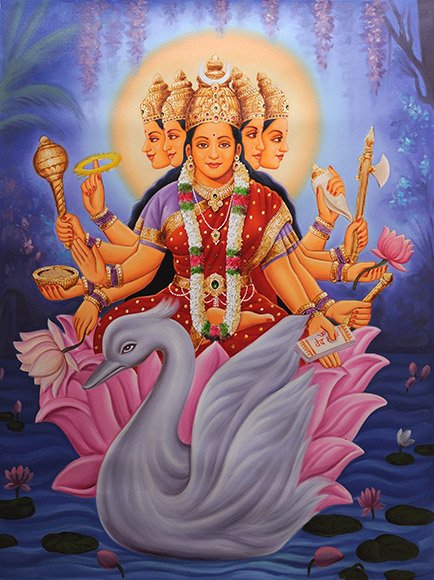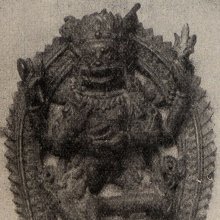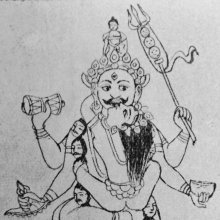Kamini, Kāminī, Kāmiṉi, Kaminī: 24 definitions
Introduction:
Kamini means something in Buddhism, Pali, Hinduism, Sanskrit, Marathi, Jainism, Prakrit, Hindi, biology, Tamil. If you want to know the exact meaning, history, etymology or English translation of this term then check out the descriptions on this page. Add your comment or reference to a book if you want to contribute to this summary article.
Images (photo gallery)
In Hinduism
Purana and Itihasa (epic history)
Source: archive.org: Shiva Purana - English TranslationKāminī (कामिनी) refers to the “beloved” (of the lovers), according to the Śivapurāṇa 2.3.18 (“Description of the perturbation caused by Kāma”).—Accordingly, as Brahmā narrated: “After going there, the haughty Kāma, deluded by Śiva’s magic power, stationed himself, after first spreading the enchanting power of Spring all around. [...] O sage, diverse sounds of the hummings of the bees rang sweet in the ears of everyone heightening temptations of love. The bright light [i.e., viśada] of the moon scattered all around appeared to be the emissary of lovers and their beloveds [i.e., kāminī—kāmināṃ kāminīnāṃ ca]. [...]”.
Source: Cologne Digital Sanskrit Dictionaries: The Purana IndexKāminī (कामिनी).—A group of women who came from the mouth of Asura Bala when he yawned.*
- * Bhāgavata-purāṇa V. 24. 16.

The Purana (पुराण, purāṇas) refers to Sanskrit literature preserving ancient India’s vast cultural history, including historical legends, religious ceremonies, various arts and sciences. The eighteen mahapuranas total over 400,000 shlokas (metrical couplets) and date to at least several centuries BCE.
Vaishnavism (Vaishava dharma)
Source: Devotees Vaishnavas: Śrī Garga SaṃhitāKāminī (कामिनी) refers to the seventeenth of twenty-six ekādaśīs according to the Garga-saṃhitā 4.8.9. Accordingly, “to attain Lord Kṛṣṇa’s mercy you should follow the vow of fasting on ekādaśī. In that way You will make Lord Kṛṣṇa into your submissive servant. Of this there is no doubt”. A person who chants the names of these twenty-six ekādaśīs (e.g., Kāminī) attains the result of following ekādaśī for one year.

Vaishnava (वैष्णव, vaiṣṇava) or vaishnavism (vaiṣṇavism) represents a tradition of Hinduism worshipping Vishnu as the supreme Lord. Similar to the Shaktism and Shaivism traditions, Vaishnavism also developed as an individual movement, famous for its exposition of the dashavatara (‘ten avatars of Vishnu’).
Chandas (prosody, study of Sanskrit metres)
Source: Shodhganga: a concise history of Sanskrit Chanda literature1) Kāminī (कामिनी) is the alternative name of a Sanskrit metre (chandas) mentioned by Hemacandra (1088-1173 C.E.) in his auto-commentary on the second chapter of the Chandonuśāsana. Kāminī corresponds to Taragavatī. Hemacandra gives these alternative names for the metres by other authorities (like Bharata), even though the number of gaṇas or letters do not differ.
2) Kāminī (कामिनी) refers to one of the 135 metres (chandas) mentioned by Nañjuṇḍa (1794-1868 C.E.) in his Vṛttaratnāvalī. Nañjuṇḍa was a poet of both Kannada and Sanskrit literature flourished in the court of the famous Kṛṣṇarāja Woḍeyar of Mysore. He introduces the names of these metres (e.g., Kāminī) in 20 verses.

Chandas (छन्दस्) refers to Sanskrit prosody and represents one of the six Vedangas (auxiliary disciplines belonging to the study of the Vedas). The science of prosody (chandas-shastra) focusses on the study of the poetic meters such as the commonly known twenty-six metres mentioned by Pingalas.
Natyashastra (theatrics and dramaturgy)
Source: Wisdom Library: Nāṭya-śāstraKāminī (कामिनी) is the name of a meter belonging to the Uṣṇik class of Dhruvā (songs) described in the Nāṭyaśāstra chapter 32:—“the metre which has in its feet of seven syllables short syllables alternating with long ones, is kāminī”.

Natyashastra (नाट्यशास्त्र, nāṭyaśāstra) refers to both the ancient Indian tradition (shastra) of performing arts, (natya—theatrics, drama, dance, music), as well as the name of a Sanskrit work dealing with these subjects. It also teaches the rules for composing Dramatic plays (nataka), construction and performance of Theater, and Poetic works (kavya).
Ayurveda (science of life)
Nighantu (Synonyms and Characteristics of Drugs and technical terms)
Source: WorldCat: Rāj nighaṇṭuKāminī (कामिनी) is another name for Vandāka, a medicinal plant identified with two possibly species verse, according to verse 5.68-70 of the 13th-century Raj Nighantu or Rājanighaṇṭu. The fifth chapter (parpaṭādi-varga) of this book enumerates sixty varieties of smaller plants (kṣudra-kṣupa). Together with the names Kāminī and Vandāka, there are a total of sixteen Sanskrit synonyms identified for this plant. Note: Nāḍkarṇī identifies Vandāka with 1) Vanda roxburghii R. Br. while Th. B.S. et al identifies it with 2) Loranthus longiflorus Desr. of.

Āyurveda (आयुर्वेद, ayurveda) is a branch of Indian science dealing with medicine, herbalism, taxology, anatomy, surgery, alchemy and related topics. Traditional practice of Āyurveda in ancient India dates back to at least the first millenium BC. Literature is commonly written in Sanskrit using various poetic metres.
Shaktism (Shakta philosophy)
Source: Google Books: ManthanabhairavatantramKāminī (कामिनी) refers to “passionate”.—Here in the holy site of Kāmarūpa, the goddess’s spiritual energy is particularly intense, even the goddess is amazed to perceive the intensity of her arousal and for a moment is ‘deluded’, loosing consciousness, overawed by the powerful beauty of her own form reflected in the goddess of the place. Here she is young and passionate (kāminī) and what she reveals gives even the god who merely beholds her here 'the attainment of the fruit of the bliss of passion', that is, the empowering energy of the Transmission. Spiritually aroused and arousing in this way, she is accordingly called Kāmeśvarī—‘the Mistress of Passion’.

Shakta (शाक्त, śākta) or Shaktism (śāktism) represents a tradition of Hinduism where the Goddess (Devi) is revered and worshipped. Shakta literature includes a range of scriptures, including various Agamas and Tantras, although its roots may be traced back to the Vedas.
Yoga (school of philosophy)
Source: ORA: Amanaska (king of all yogas): A Critical Edition and Annotated Translation by Jason BirchKāminī (कामिनी) refers to an “amorous woman”, according to the Amanaska Yoga treatise dealing with meditation, absorption, yogic powers and liberation.—Accordingly, as Īśvara says to Vāmadeva: “[...] [Now], I shall define the nature of that highest, mind-free absorption which arises for those devoted to constant practice. [...] By means of an absorption of eight Palas, the [Yogin’s] sexual desire ceases and it will never arise [again, even] when he is embraced by an amorous woman (kāminī-āliṅgita). [...]”.

Yoga is originally considered a branch of Hindu philosophy (astika), but both ancient and modern Yoga combine the physical, mental and spiritual. Yoga teaches various physical techniques also known as āsanas (postures), used for various purposes (eg., meditation, contemplation, relaxation).
In Buddhism
Tibetan Buddhism (Vajrayana or tantric Buddhism)
Source: Wisdom Library: Tibetan BuddhismKāminī (कामिनी) is the name of Dūtī (i.e., messengers of Lord Vajrapāṇi) mentioned as attending the teachings in the 6th century Mañjuśrīmūlakalpa: one of the largest Kriyā Tantras devoted to Mañjuśrī (the Bodhisattva of wisdom) representing an encyclopedia of knowledge primarily concerned with ritualistic elements in Buddhism. The teachings in this text originate from Mañjuśrī and were taught to and by Buddha Śākyamuni in the presence of a large audience (including Kāminī).
Source: archive.org: The Indian Buddhist IconographyKāminī (कामिनी) is one of the twenty-four Goddesses surrounding Buddhakapāla in the buddhakapālamaṇḍala, according to the 5th-century Sādhanamālā (a collection of sādhana texts that contain detailed instructions for rituals).—Buddhakapāla refers to one of the various emanations of Akṣobhya and the sādhana says that when Heruka is embraced by Citrasenā he gets the name of Buddhakapāla.—Kāminī stands in the north-east of the middle circle. She has a blue colour two arms, one face, ornaments of bones, brown hair rising upwards but no garlands of heads. She carries the kapāla in the left and the kartri in the right, and dances in the ardhaparyaṅka attitude.
Source: academia.edu: A Critical Study of the Vajraḍākamahātantrarāja (II)Kāminī (कामिनी) is the name of a Goddess (Devī) presiding over Māyāpura: one of the twenty-four sacred districts mentioned in the 9th century Vajraḍākatantra (chapter 18). Her weapons are the vajra and śakti. Furthermore, Kāminī is accompanied by the Kṣetrapāla (field-protector) named Bhīma and their abode is a bhūta-tree.
Source: academia.edu: The Structure and Meanings of the Heruka Maṇḍala1) Kāminī (कामिनी) is the name of a Ḍākinī who, together with the Vīra (hero) named Jñānaḍāka forms one of the 36 pairs situated in the Vajracakra, according to the 10th century Ḍākārṇava chapter 15. Accordingly, the vajracakra refers to one of the four divisions of the sahaja-puṭa (‘innate layer’), situated within the padma (lotus) in the middle of the Herukamaṇḍala. The 36 pairs of Ḍākinīs [viz., Kāminī] and Vīras each have one face and four arms; they hold a skull bowl, a skull staff, a small drum and a knife; they are dark-bluish-black in color.
Note: Generally, the name of this goddess is Mohanī and not Yuminī. Manuscript C names her Kāminī. The Tibetan translation is skyes gshin rje ma. Her name is Yaminī (gshin rje ma) in Jayasena’s Ratnapadmarāganidhi (D 1516, 8 v 2 and 25 v 5).
2) Kāminī (कामिनी) is also the name of a Ḍākinī who, together with the Vīra (hero) named Kāmin forms one of the 36 pairs situated in the Jñānacakra, according to the same work. Accordingly, the jñānacakra refers to one of the three divisions of the saṃbhoga-puṭa (‘enjoyment layer’), situated in the Herukamaṇḍala. The 36 pairs of Ḍākinīs [viz., Kāminī] and Vīras are white in color; the shapes of their faces are in accordance with their names; they have four arms; they hold a skull bowl, a skull staff, a small drum, and a knife.
Source: 84000: Sampuṭodbhava Tantra (Emergence from Sampuṭa)Kāminī (कामिनी) refers to one of the primary thirty-two energy-channels in the body, according to the Sampuṭodbhavatantra chapter 1.—Accordingly, “[Vajragarbha asked, ‘What subtle energy channels are in the body?’]—The Blessed One said, ‘There are one hundred and twenty of them, corresponding to the divisions within the four cakras. The chief ones, those with bodhicitta as their innate nature, are thirty-two in number. They are: [i.e., Kāminī] [...]’.”.

Tibetan Buddhism includes schools such as Nyingma, Kadampa, Kagyu and Gelug. Their primary canon of literature is divided in two broad categories: The Kangyur, which consists of Buddha’s words, and the Tengyur, which includes commentaries from various sources. Esotericism and tantra techniques (vajrayāna) are collected indepently.
Biology (plants and animals)
Source: Wisdom Library: Local Names of Plants and DrugsKamini [कामिनी] in the Hindi language is the name of a plant identified with Murraya paniculata Murraya paniculata (L.) Jacq. from the Rutaceae (Lemon) family having the following synonyms: Murraya exotica. For the possible medicinal usage of kamini, you can check this page for potential sources and references, although be aware that any some or none of the side-effects may not be mentioned here, wether they be harmful or beneficial to health.
Kamini in the Sanskrit language is the name of a plant identified with Viscum articulatum Burm.f. from the Santalaceae (Sandalwood) family having the following synonyms: Viscum nepalense.
Source: Google Books: CRC World Dictionary (Regional names)Kamini in India is the name of a plant defined with Viscum articulatum in various botanical sources. This page contains potential references in Ayurveda, modern medicine, and other folk traditions or local practices It has the synonym Korthalsella articulata (Burm.f.) Laing (among others).
Example references for further research on medicinal uses or toxicity (see latin names for full list):
· Transactions and Proceedings of the New Zealand Institute (1914)
· Bulletin de la Société Botanique de France (1896)
· Exerc. Phyt. (1792)
· Prodromus Florae Nepalensis (1825)
· Denkschriften der Kaiserlichen Akademie der Wissenschaften. Mathematisch-naturwissenschaftliche Klasse (1872)
· Ethnobotany (2004)
If you are looking for specific details regarding Kamini, for example side effects, health benefits, pregnancy safety, chemical composition, diet and recipes, extract dosage, have a look at these references.

This sections includes definitions from the five kingdoms of living things: Animals, Plants, Fungi, Protists and Monera. It will include both the official binomial nomenclature (scientific names usually in Latin) as well as regional spellings and variants.
Languages of India and abroad
Marathi-English dictionary
Source: DDSA: The Molesworth Marathi and English Dictionarykāmiṇī (कामिणी).—f Jaundice. See kāmīṇa. 2 (Incorrect for kāminī) A woman.
--- OR ---
kāminī (कामिनी).—f (S) and in poetry, kāminā or ṇā f An amorous woman, a loving or a beloved woman, a mistress. 2 A woman gen. Ex. gauḍī mādhvī paiṣṭhī || tīna madya pragaṭa janīṃ || cauthēṃ madya tēṃ kā0 || durgandha nhāṇī pāpācī ||.
Marathi is an Indo-European language having over 70 million native speakers people in (predominantly) Maharashtra India. Marathi, like many other Indo-Aryan languages, evolved from early forms of Prakrit, which itself is a subset of Sanskrit, one of the most ancient languages of the world.
Sanskrit dictionary
Source: Cologne Digital Sanskrit Dictionaries: Edgerton Buddhist Hybrid Sanskrit DictionaryKāminī (कामिनी).—name of a goddess: Sādhanamālā 502.8.
Source: Cologne Digital Sanskrit Dictionaries: Monier-Williams Sanskrit-English Dictionary1) Kāminī (कामिनी):—[from kāmin > kāma] a f. a loving or affectionate woman, [Manu-smṛti viii, 112; Rāmāyaṇa; Meghadūta; Harivaṃśa; Raghuvaṃśa] etc.
2) [v.s. ...] a timid woman, [cf. Lexicographers, esp. such as amarasiṃha, halāyudha, hemacandra, etc.]
3) [v.s. ...] a woman in general, [cf. Lexicographers, esp. such as amarasiṃha, halāyudha, hemacandra, etc.]
4) [v.s. ...] a form of Devī, [Hemādri’s Caturvarga-cintāmaṇi]
5) [v.s. ...] the plant Vanda Roxburghii, [cf. Lexicographers, esp. such as amarasiṃha, halāyudha, hemacandra, etc.]
6) [v.s. ...] the plant Curcuma aromatica, [cf. Lexicographers, esp. such as amarasiṃha, halāyudha, hemacandra, etc.]
7) [v.s. ...] a spirituous liquor, [cf. Lexicographers, esp. such as amarasiṃha, halāyudha, hemacandra, etc.]
8) [v.s. ...] b (f. of kāmin q.v.)
Source: DDSA: Paia-sadda-mahannavo; a comprehensive Prakrit Hindi dictionary (S)Kāminī (कामिनी) in the Sanskrit language is related to the Prakrit word: Kāmiṇī.
Sanskrit, also spelled संस्कृतम् (saṃskṛtam), is an ancient language of India commonly seen as the grandmother of the Indo-European language family (even English!). Closely allied with Prakrit and Pali, Sanskrit is more exhaustive in both grammar and terms and has the most extensive collection of literature in the world, greatly surpassing its sister-languages Greek and Latin.
Hindi dictionary
Source: DDSA: A practical Hindi-English dictionaryKāminī (कामिनी):—(nf) a (lustful) woman; beautiful lady.
...
Prakrit-English dictionary
Source: DDSA: Paia-sadda-mahannavo; a comprehensive Prakrit Hindi dictionaryKāmiṇī (कामिणी) in the Prakrit language is related to the Sanskrit word: Kāminī.
Prakrit is an ancient language closely associated with both Pali and Sanskrit. Jain literature is often composed in this language or sub-dialects, such as the Agamas and their commentaries which are written in Ardhamagadhi and Maharashtri Prakrit. The earliest extant texts can be dated to as early as the 4th century BCE although core portions might be older.
Kannada-English dictionary
Source: Alar: Kannada-English corpusKāmiṇi (ಕಾಮಿಣಿ):—[noun] = ಕಾಮಾಲೆ [kamale].
--- OR ---
Kāmini (ಕಾಮಿನಿ):—
1) [noun] a lustful woman.
2) [noun] a beautiful woman.
3) [noun] an affectionate woman.
4) [noun] a woman in gen.
Kannada is a Dravidian language (as opposed to the Indo-European language family) mainly spoken in the southwestern region of India.
See also (Relevant definitions)
Starts with: Kamini-kusum, Kaminicitta, Kaminika, Kaminikama, Kaminikanta, Kaminipriya, Kaminisha, Kaminivara, Kaminyalingita.
Ends with (+7): Akacakamini, Akkamini, Amarakamini, Ambudhakamini, Ambudhikamini, Amtukamini, Chvaskamini, Dikkamini, Divyakamini, Girikamini, Jvalakamini, Kamakamini, Khakamini, Lepakamini, Mahakamini, Mirukakamini, Nikamini, Parakamini, Pratikamini, Sakamini.
Full-text (+32): Kaminisha, Pratikamini, Veshyakamini, Dikkamini, Khakamini, Alingita, Kaminipriya, Kaminikanta, Kamin, Ambudhikamini, Kamini-kusum, Akacakamini, Ambudhakamini, Surakamini, Ratinaga, Lepakamini, Khabhranti, Kaminika, Beautiful women, Amorous women.
Relevant text
Search found 27 books and stories containing Kamini, Kāminī, Kāmiṇī, Kāmiṇi, Kāmini, Kāmiṉi, Kaminī; (plurals include: Kaminis, Kāminīs, Kāmiṇīs, Kāmiṇis, Kāminis, Kāmiṉis, Kaminīs). You can also click to the full overview containing English textual excerpts. Below are direct links for the most relevant articles:
Garga Samhita (English) (by Danavir Goswami)
Verse 4.8.15 < [Chapter 8 - In the Story of the Yajña-sītās, the Glories of Ekādaśī]
Verse 5.15.27 < [Chapter 15 - Seeing Sri Radha]
Verse 1.4.28 < [Chapter 4 - Description of Questions About the Lord’s Appearance]
Kavyamimamsa of Rajasekhara (Study) (by Debabrata Barai)
Part 7.14 - Poetic conventions regarding to the God Kāmadeva < [Chapter 5 - Analyasis and Interpretations of the Kāvyamīmāṃsā]
Kamashastra Discourse (Life in Ancient India) (by Nidheesh Kannan B.)
2. Works on Kāmaśāstra (c): Nāgarasarvasva < [Chapter 2 - An Appraisal of Kāmaśāstra Works in Sanskrit]
2. Works on Kāmaśāstra (j): Śṛṅgārarasaprabandhadīpikā < [Chapter 2 - An Appraisal of Kāmaśāstra Works in Sanskrit]
Sahitya-kaumudi by Baladeva Vidyabhushana (by Gaurapada Dāsa)
Text 10.187 < [Chapter 10 - Ornaments of Meaning]
Text 7.142 < [Chapter 7 - Literary Faults]
Text 11.9 < [Chapter 11 - Additional Ornaments]
The Bhagavata Purana (by G. V. Tagare)
Chapter 24 - Rāhu’s Position and the Subterranean Regions < [Book 5 - Fifth Skandha]
The Skanda Purana (by G. V. Tagare)
Chapter 20 - Merit from Gift of Lands < [Section 1 - Veṅkaṭācala-māhātmya]
Chapter 259 - Prayer to the Bull < [Section 1 - Tīrtha-māhātmya]

